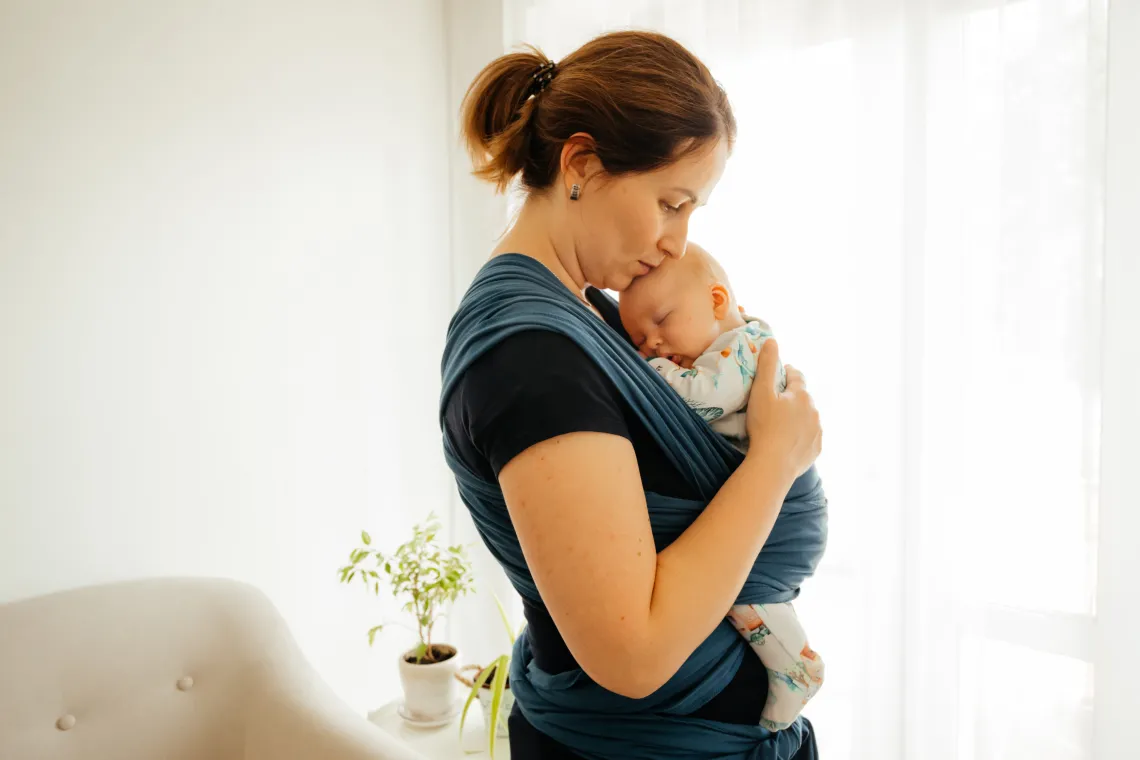A mother’s touch: can close physical contact with newborns reduce mother and baby’s dependence on drug treatment?
Researchers hope to prove that babywearing rapidly improves recovery for babies born with NAS while helping mothers with substance use disorder.

A mother practicing babywearing.
As the national opioid epidemic persists, University of Arizona Health Sciences researchers are studying whether babywearing, the act of holding an infant with the use of a carrier or cloth tied to secure the infant to the caregiver, offers any benefits for babies experiencing withdrawal from opioids and mothers with opioid use disorder (OUD).
The practice of babywearing has been around for thousands of years. It was originally done out of necessity, such as when working the fields or searching for food, making breastfeeding and putting the baby to sleep more convenient. As mothers took up work in offices and other settings that did not allow babywearing, the benefits for the baby and mother were lost. Yet, babywearing is now resurfacing with the rising popularity of attachment parenting, which emphasizes close physical and emotional bonding with infants.
In an ongoing study at the University of Arizona Health Sciences Comprehensive Center for Pain & Addiction, the U of A College of Medicine – Tucson’s Department of Family and Community Medicine and Banner – University Medical Center Tucson are exploring whether babywearing may offer positive hormonal effects for babies suffering from Neonatal Abstinence Syndrome (NAS), or more specifically Neonatal Opioid Withdrawal Syndrome (NOWS), as well as help mothers combat drug addiction.
The study, “Role of Our hormones in Bonding with Infants and New moms” (ROBIN), was funded by a National Institutes of Health grant.
“I think one of the keys to the success of the program is that it not only treats the babies, which is fantastic, but it also treats the mothers,” said Todd Vanderah, PhD, director of the Comprehensive Center for Pain & Addiction, Regents Professor and head of the Department of Pharmacology in the College of Medicine – Tucson, and member of the BIO5 Institute. “It gives the mothers something more with babywearing creating increased bonding with the child, which prompts mothers to reduce their drug use.”
Medication for Opioid Use Disorder (MOUD) uses medications, including methadone and buprenorphine, to help individuals stop using substances, specifically opioids, safely and effectively. According to Lisa Grisham, MS, NNP, a neonatal nurse practitioner at Banner – University Medical Center Tucson and director of the Family-Centered Neonatal Abstinence Syndrome Program at Banner – University Medicine, it is common for babies with NAS/NOWS to receive pharmacological treatment to help manage and alleviate withdrawal symptoms such as irritability, tremors, gastrointestinal distress, and in rare cases, seizures.

According to Vanderah, researchers are finding that babies being held skin-to-skin by their mothers can discontinue medications within a few days, compared to weeks for those not being held. Babywearing is similar to skin-to-skin but can be done in public settings and with caregivers other than the parents.
This study is needed now more than ever with the national opioid epidemic increasing the risk of infants developing NAS/NOWS due to mothers’ drug use while pregnant. The stakes are incredibly high, with serious complications for infants, including developmental delays and sudden death. According to the Federal Communication Commission, annual opioid overdose deaths still remain more than eight times higher than in 1999.
Monitoring Hormones in Baby and Mother
For over 40 years, doctors have been struggling to treat babies born with withdrawal symptoms from in-utero substance exposure. Babywearing as one form of treatment has already shown some promise in the field. One recent U of A study found that babywearing decreased the baby and the mother’s heart rates, and it reduced them even more when the infant’s scalp was also stroked. Nurse-perception surveys have revealed consistently that babywearing and close contact implicitly works for babies with NAS in the neonatal intensive care unit.

Lisa Grisham, MS, NNP.
Now, Grisham hopes the ROBIN study will shed light on the science behind why it works. This research started as part of her dissertation as a doctoral candidate in the U of A College of Nursing.
The study randomly assigns mothers to either babywearing or stroller walking, the latter of which involves less contact. Over the course of the study, mothers fill out surveys regarding cravings, substance use and infant behavior, and they visit the research lab about five times. Researchers measure and monitor hormone levels in the baby and mother before, during and directly after they finish their assigned activity.
“What we are seeing in the NICU is that these are really fussy babies who respond well to babywearing,” Grisham said. “They like to be snuggled tight, they like to be close to someone, and they like the movement.”
According to Grisham, researchers are investigating whether cortisol, a hormone associated with stress, decreases and if oxytocin, a hormone associated with bonding and social connection, increases.
Throughout this process, mothers are also given the opportunity to treat their substance use disorder with the help of medical professionals.

Alicia Allen, PhD.
Alicia Allen, PhD, director of the Recovery through ENgaging and Empowering Women (RENEW) Research Team and an associate professor in the U of A College of Medicine – Tucson, said, “During pregnancy, folks are more likely to get engaged with recovery and treatment programs, but unfortunately, the risk of returning to use increases postpartum. This is clearly a great opportunity where mom has more support and access to services.”
Analyzing Results, Looking Towards the Future
The families involved have given exceptionally positive feedback regarding the study in their satisfaction surveys. Grisham said others have expressed excitement about the opportunity to contribute to scientific research.
“Many families with opioid use disorder come from lower socio-economic statuses, so they really appreciate the extra baby products and the financial incentives that come with being a study participant, but they also comment on the opportunity to help with research,” Grisham said. “When they come in, I try to tell them what a great job they are doing and also take some time to listen to them because experiencing substance use disorder while being a new mom is a lot to take on.”
Researchers hope to complete enrollment in the ROBIN study by the end of 2024 and have quantifiable evidence by 2025. Allen, a member of the BIO5 Institute, said if the results support positive hormonal reactions, then the practice could be adopted in the medical community as a form of treatment.
The study is also part of a larger effort by the Comprehensive Center for Pain & Addiction and others in the health care industry to develop more female-specific studies regarding substance use disorders and chronic pain.
“This area of study is definitely growing,” said Allen, who is a member of the Comprehensive Center for Pain & Addiction. “Dr. Vanderah and others in the center have been very supportive in helping mothers with substance use disorder and babies born with neonatal abstinence syndrome. Some national initiatives have really highlighted the need for women’s health research as well as research focused on the opioid epidemic.”

